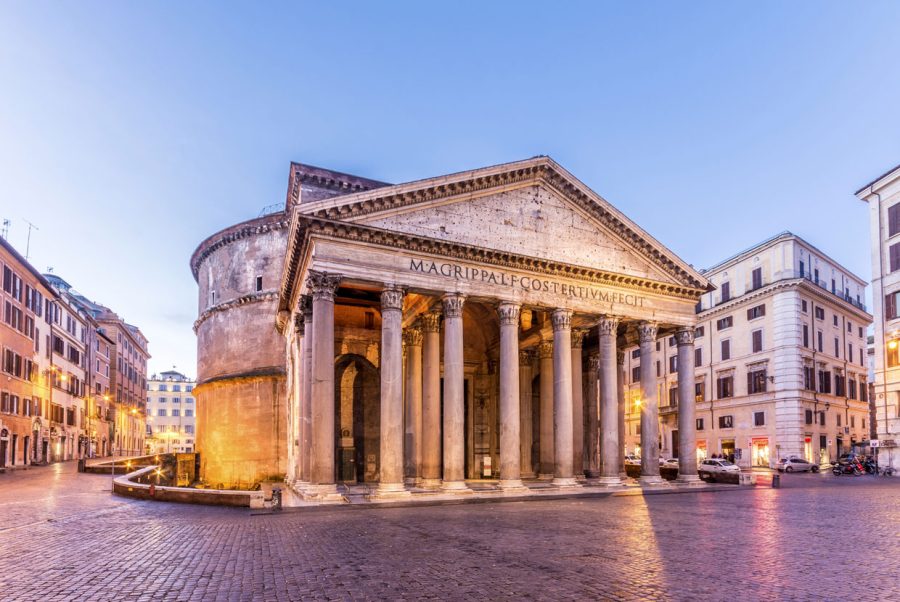Cracking the Code of ‘Self-Healing’ Roman Concrete
March 1, 2023
Along with Greece, Egypt and Britain, Rome was one of the greatest ancient civilizations of all time. Beginning in 27 BCE, and lasting a little over 5 centuries, into 476 (CE), the Roman Empire helped propel the reigns of many important figures, such as Julius Caesar. The ancient Romans had an outstanding army, commerce and agriculture, and an incredible intellectual foundation. Unfortunately, not all that much of the Roman Empire remains today…except for their architecture.
Roman Architecture
The Roman Empire had an amazing point of view about their architecture. Their works that they build, while imitating Greek styles, were nearly perfectly executed with fine amounts of precision. They also cared much about hygiene, with the installment of plumbing systems, dams, and aqueducts.
One of the notable buildings that the Romans created is the Pantheon, a large temple dedicated to all of the Roman gods and goddesses. In the history of Roman architecture, it has the biggest dome that’s made of bricks. Its iconic columns inspire many other works of architecture around the world.
But there’s one mystery that’s remained unsolved for centuries. Since the ancient Roman architecture has been here for so long, how is it still standing today? And even more, the cracks that are found in the concrete seemingly disappear over time. What’s the secret behind the concrete? Chemists have just recently discovered the hidden recipe for the amazing Roman stone.
Cracking the Code
The concrete that the Romans used to construct their architecture is incredibly durable, even more so than the concrete that we use today. It seems to self heal as well as survive for thousands of years. The Pantheon, although being built so many centuries ago, still seems like it’s brand new.
A group of scientists, stemming from MIT and Harvard, may have finally solved the mystery. Little white flecks, previously seen as imperfections in the stone, might be the answer. The white flecks are known as ‘lime clasts’, which were assumed to be due to careless and flawed processes. According to the leader of the team, Admir Masic, “…how likely is it that every operator was not mixing properly and every building has a flaw?” The Romans, a very precise group, wouldn’t make that many of the same exact mistakes. Therefore, these small white imperfections might just be what makes the concrete perfect.
Re-creating Concrete
As a quick background of concrete, it’s usually composed of a few materials. One of such is mortar, a liquid that is used as a binding agent – something that holds other materials together. The second of these is aggregates, which are little pieces of gravel sand, small rocks, etc.
The science group was trying to recreate the Roman concrete that has stood the test of time. They were using an ancient technique called hot-mixing, where the aggregates were composed of volcanic ash and calcium oxide (known as quicklime). Those calcium oxide bits soon became ubiquitous in Roman structures, as they cemented into those little white flecks. The thing is, during this process, it exerts a lot of heat. The heat exerted then turns into an explosion – meaning that this can be very dangerous.
Luckily for the scientific team, their process just produced vapor, the concrete, and no explosion! Although scientists have been trying to mimic Roman concrete for ages, nobody has ever come this far yet, save for the MIT-Harvard team’s idea to incorporate hot-mixing. The team didn’t just stumble upon this idea, however. Instead, they read over many texts by ancient scientists, such as the architect Vesuvius and the historian Pliny, where they discovered that hot-mixing was a reasonable thing to try.
By definition, calcium is a compound in which it works in a self-healing way. The calcium in the lime clasts crumbles and dissolves into extremely tiny particles. The particles fill up the fracture in the rock. Once water comes in contact with the calcium, it reacts with the water and re-crystallizes into larger crystals.
In the scenario of the Roman concrete, whenever a fissure develops (as fissures do over time), the calcium gets to work. The next time it rains, the calcium dissolves and recrystallizes to get the dazzling effect of self-healing concrete.
This only really happens when the lime clasts were added to the rest of the concrete when it’s heated. This is extremely dangerous, as it produces explosions. But it seems to work really well.
Masic and his team published a scientific journal entry on January 6. According to an article from Science News (These chemists cracked the code to long-lasting Roman Concrete), ‘“The results were stunning.’ Masic said. The blocks incorporating hot-mixed cement healed within two to three weeks. The concrete without hot-mixed cement never healed at all.” So finally, scientists have figured out what makes Roman concrete so strong.
A Gift for the Planet
The thing about this new discovery is that it’s not only taken from the past, but it can be given to the future. The concrete that makes up these ancient buildings not only is durable, but it self heals. Architecture from ancient Roman times, such as the Pantheon, has stood strong for nearly 20 centuries – 2,000 years. Meanwhile, the architecture today lasts around 150 years.
It’s simple to see that the buildings from ancient times last way longer than current buildings, without using steel or iron implements as reinforcements. When people have to create new concrete structures, it creates many emissions and lots of damage to the environment, whether directly or indirectly. When concrete gets manufactured, lots more carbon adds to the environment. But with the discovery of self-healing concrete, it lasts longer and can reduce the carbon footprint.
All in all, it seems like the Roman architecture of old has some secrets that were just dug up. And with these nuggets of knowledge coming from nearly two millennia ago, we can help change the future of both construction as well as saving the environment. Seems like a win-win!
Works Cited
Ancient Roman concrete was incredibly strong — scientists may have just figured out why. (2023, January 16). Business Insider. https://www.businessinsider.com/what-secrete-ancient-roman-concrete-mystery-may-be-solved-2023-1?international=true&r=US&IR=T
Gramling, C. (2023, January 17). These chemists cracked the code to long-lasting Roman concrete. Science News. https://www.sciencenews.org/article/chemists-long-lasting-roman-concrete
Hunt, K. C. (2023, January 9). Mystery of why Roman buildings have survived so long has been unraveled, scientists say. CNN. https://edition.cnn.com/style/article/roman-concrete-mystery-ingredient-scn/index.html
The Editors of Encyclopaedia Britannica. (2009, January 23). Roman Empire | Definition, History, Time Period, Map, & Facts. Encyclopedia Britannica. https://www.britannica.com/place/Roman-Empire
Pantheon image. (n.d.). Italian Dual Citizenship. https://www.google.com/url?sa=i&url=https%3A%2F%2Fwww.italiandualcitizenship.net%2Fwhat-you-should-know-about-the-history-of-the-pantheon-in-rome%2F&psig=AOvVaw357c3r5uzzZv3CadSlV5ba&ust=1675280615371000&source=images&cd=vfe&ved=0CA0QjhxqFwoTCOiWw-PI8vwCFQAAAAAdAAAAABAD





